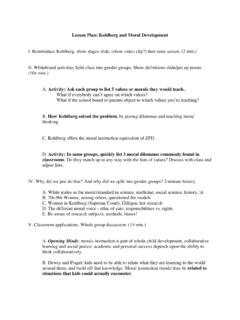Transcription of Ethical Dilemmas in Psychotherapy
1 3 INTRODUCTION: PROBLEMS, PITFALLS, AND POTENTIALS1 The life of a professional psychologist can be rewarding but also difficult. Although we feel pride in our work and have helped many people, we also lose sleep some nights while deliberating Ethical decisions. Our conversations with other psychologists over the years and the literature suggest that we are not alone (Pope & Vetter, 1992). In many situations, psychologists need to balance competing concerns and conflicting obligations, or negotiate among overarching Ethical principles that appear to collide. The goal of this book is to help professional psychologists and other psychotherapists, and counselors address difficult or upsetting situations in which ethics codes, laws, and other professional guidelines do not or cannot provide clear direction.
2 The book 1 Proper steps were taken to protect the confidentiality of all individuals mentioned in the case examples throughout this Dilemmas in Psychotherapy : Positive Approaches to Decision Making, by Knapp, Gottlieb, and HandelsmanCopyright 2015 by the American Psychological Association. All rights American Psychological Association4 Ethical Dilemmas IN PSYCHOTHERAPYmay also be of interest to psychologists who conduct research on or who teach Psychotherapy . Consider this example:A Conflict of ValuesDr. Yasuto was treating a suicidal patient who refused to admit himself into a psychiatric hospital but agreed to make a commitment to meet with her next week if I am still around.
3 According to the laws in the state where Dr. Yasuto practices, the patient would have qualified for an involuntary psychiatric hospitalization, and such hospitalization would temporarily ensure the patient s safety. However, given the patient s lack of response to medication, Dr. Yasuto questioned the benefit of such hospitalization and feared that hospitalizing him involuntarily may cause him to lose trust in her and, on discharge, to drop out of therapy. Dr. Yasuto then recalled her own father s suicide and the pain it caused her and her this example, Dr. Yasuto faced at least four challenges. The first chal-lenge involved conflicting principles: She felt a need to act in accordance with the overarching principles of beneficence (acting to promote the patient s well-being) and nonmaleficence (acting to avoid allowing harm to come to the patient).
4 She could have done so by initiating the involuntary hospitalization that would have ensured her patient s immediate safety. However, Dr. Yasuto also felt a need to respect another overarching Ethical principle: her patient s right to autonomous decision making. She could have adhered to that prin-ciple by respecting the patient s wish to be treated as an outpatient. The second challenge concerned her professional role and its relationship to her personal life and experiences: She must separate and weigh the appropriate influence of her professional judgment and her experience with her father s death. The third challenge was how she was going to make the best possible decision: She may ask herself if her decision would be unduly influenced by factors, such as her desire for her patient s loyalty, admiration, and fees; a fear of litigation; and a desire to be rid of the inconvenience involved.
5 Dr. Yasuto also needs to consider whether any of the standards of the American Psychological Association (APA, 2010) Ethical Principles of Psychologists and Code of Conduct (hereafter referred to as the APA Ethics Code) would apply and, if so, how to implement Yasuto had to make a decision that could have substantially affected her, her patient, and the lives of others, and she had to make it quickly. Psychologists often find themselves in similar situations, and, at these times, they may feel moral distress and uncertainty about whether they can balance their moral obli-gations other times, psychologists do not feel a conflict in values.
6 They and the patient can easily define and agree on their goals; they just have a difficult time reaching those goals. Consider this example:Copyright American Psychological AssociationINTRODUCTION 5 Stuck in TreatmentDr. Smith was treating a patient with major depression who was not making progress, even though Dr. Smith was using state-of-the-art, evidence-based treatment. Dr. Smith carefully reviewed the patient s file but was unable to come up with a plausible explanation. The patient appeared to be in great distress and was demoralized by the lack of progress in Smith had no confusion about his goal to ensure his patient s well-being, but he felt frustrated because he was not sure how to reach that may feel uncertain about how to balance their personal and professional values, and they may have to deal with their own strong emotions, such as fear, anger, or compassion.
7 Consider this example:Ambiguous Role: Social or Professional?A newly licensed psychotherapist, Dr. Parker was attending a dinner party given by an old college friend. The host introduced him to another guest, who said, I know you! You re my neighbor Renee s therapist! She talks about you all the time. You re great! She just saw you yesterday, right? Although he was at a social gathering and the remark was intended to be friendly, Dr. Parker could not respond as a friend or a guest. The norms of a guest at a party would be to engage in conversation and freely share knowledge of mutual acquaintances. Nonetheless, Dr. Parker needed to consider that a professional s role entails unique obligations so that actions that may be vir-tuous in a social relationship would not be virtuous for someone who has a professional relationship with a patient.
8 Although keeping the confidences of a patient at a party is a no-brainer for seasoned psychologists, other more subtle role conflicts can arise in which it can be easy to slip into the norms and values of friendship or social morality, even though a professional relation-ship may be CODES ARE NOT ENOUGHP roblems such as these occur in an Ethical gray zone, where answers are not self-evident and cannot be categorized as either black or white. No law, regulation, court case, or standard in the APA Ethics Code can tell psycholo-gists exactly what to do. The best response cannot be found in a 30-word standard from the APA Ethics Code, a succinct phrase or nutshell comment from an ethics lecture, or by a course of action dictated by a linear, logical reasoning will have a better chance of addressing these types of problems successfully if they know the current laws and ethics codes that Copyright American Psychological Association6 Ethical Dilemmas IN Psychotherapy govern the practice of psychology.
9 Ethics codes identify common ethical2 issues that psychologists encounter and then provide a prescriptive course of con-duct. Codes of professional ethics, such as the APA Ethics Code, reflect the accumulated wisdom of its members and are informed by the experiences of past generations, philosophical reflection, and legal analysis. Without the APA Ethics Code (and education about it), practicing psychologists would encounter what we call moral ambushes, a series of novel Ethical experiences or quandaries that they would be unprepared to deal with. One way or another, the accumulated wisdom of the APA Ethics Code can take psychologists only so far, because no set of rules can adequately guide practitioners through all the complex and distressing situations they may encounter.
10 Instead, prac-ticing psychologists need additional tools to deal with problems in Ethical gray zones. We devote much of this book to explaining the different ways of understanding and resolving such Dilemmas , and making excellent Ethical choices. But first we must explain a fundamental assumption that underlies our work. Our general perspective is that we should strive for the best possible outcome that is anchored in overarching Ethical principles and not be satisfied with a solution that meets only minimal legal and Ethical requirements. We refer to this approach as positive EthicsSome psychologists view the word ethics primarily in the sense of prohi-bitions, such as not plagiarizing or avoiding inappropriate social relationships with patients.














